Western Chorus frogs, also known as striped chorus frogs or midland chorus frogs, are famous for their distinctive mating calls, similar to the sound of fingers running along the teeth of a comb. But are Western chorus frogs good pets? Let’s find out.
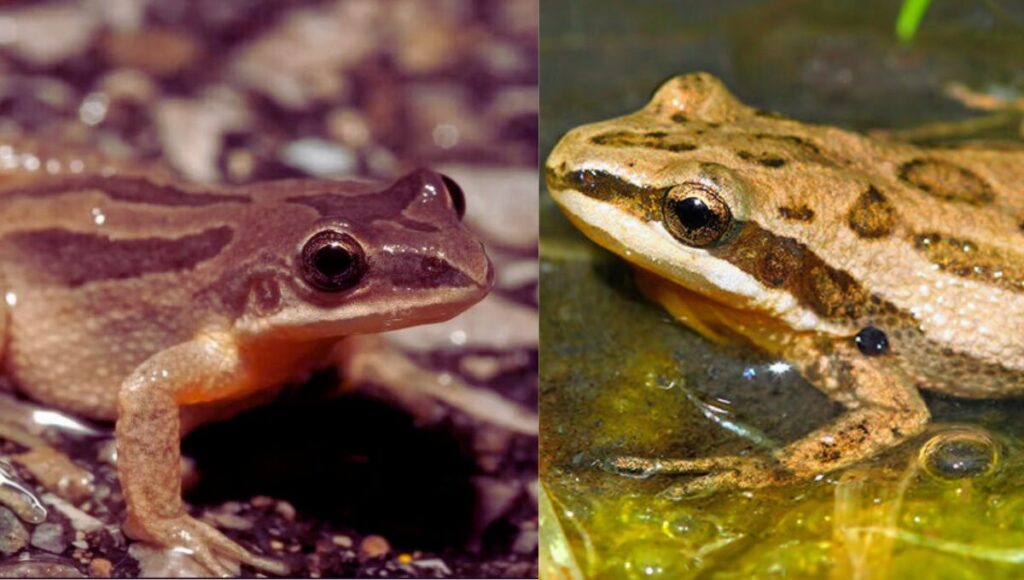
Table of Contents
Everything About Western Chorus Frogs:
In a Glimpse:
| Common Name | Western Chorus Frogs |
| Scientific Name | Pseudacris triseriata |
| Other Names | Midland Chorus Frogs, Striped Chorus Frogs |
| Maximum Length | 1.6 inches |
| Maximum Weight | N/A |
| Ranges | North America |
| Habitat | Cold and moist wetlands |
| Diet | Carnivore |
| IUCN Status | Least Concern |
| Lifespan | 2-5 years |
Geographical Range:
Midland chorus frogs’ range extended from Canada to the Gulf of Mexico and also from New Jersey to Central Arizona. The frogs usually live at a high altitude from above sea level. These chorus frogs are often found at 12000 ft (3700 m) above sea level and they can survive at -8°C.
Habitat:
Western chorus frogs live in a variety of habitats but their preferred habitat is temporary freshwater ponds or pools, marshes, swamps, meadows, and other open areas in mountains or prairies. However, they don’t like to stay in permanent waterbodies as the risk of predation on eggs and/or tadpoles increases. The temporary wetlands provide the frogs mating, breeding, and hibernation grounds. If the wetlands dry out, the chorus frogs move to fallowed agricultural fields, damp woodlands, roadside ditches, and swamps.
Physical Description:
Western Chorus frogs are small-sized (4 cm or 1.6 inches long) with greenish-grey, reddish, olive, or brown-coloured smooth skin. The colour varies with region and usually, they have three dark-brown or grey stripes (which may be broken, reduced, or absent sometimes)on their entire dorsal side. Tadpoles are grey or brown with rounded bodies, tails, finds, and dark flecks.
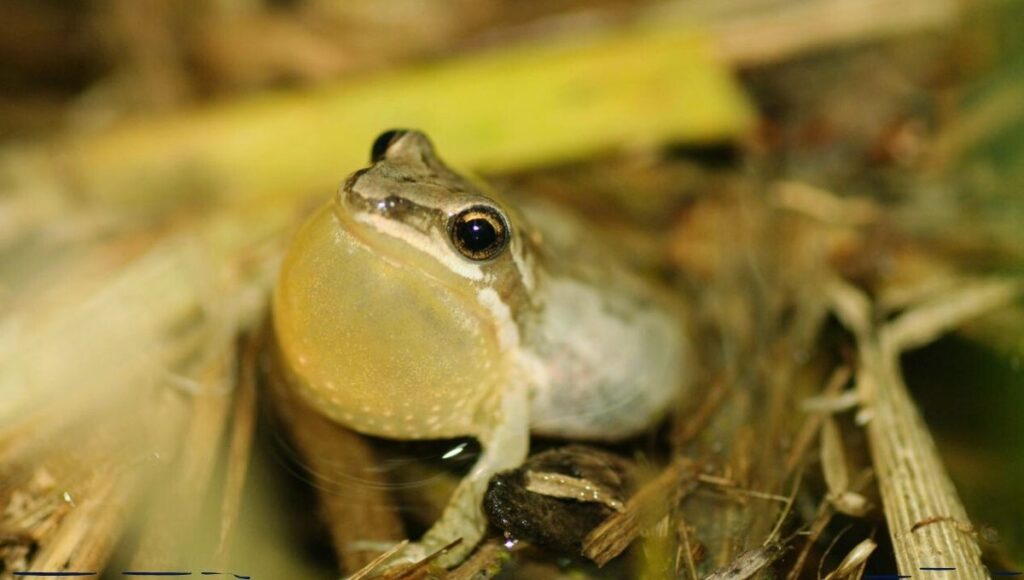
Midland chorus frogs have white or cream-coloured bellies with dark and scattered flecks. A single white stripe runs across their upper lips and a dark stripe runs across the eye and along each side from the snout to the leg. Sometimes, a dark and triangular spot is spotted on the head (for some individuals). These chorus frogs have small, rounded toes without pads which are barely webbed. The barely webbed toes make them a poor swimmer.
Sexual dimorphism is present in the species as females are larger than males. Apart from their size, females can be identified by their vocal sacs which is a dark, loose flap of skin under the throat.
Are Western Chorus frogs poisonous?
Western Chorus frogs are not toxic. They neither possess any glands that secrete poisonous chemicals nor do they attack humans physically by biting. These frogs are one of the safest frogs for humans.
Behaviour:
Western Chorus frogs are semi-aquatic, nocturnal, and solitary by nature. The chorus frogs prefer to live alone at temporary waterbodies where they have less chance to be predated and mostly come out only in the breeding season when you can actually watch them. Due to their barely webbed toes, they are neither arboreal nor a good swimmer. Hence, they prefer to live in shallow water such as marsh, swamp, pool, etc.
The tadpoles of Western chorus frogs are more active feeders than other frog species that breed at the same time. As a result, the tadpoles grow faster and take less time to metamorphosis. Thus, before drying up the place, the tadpoles can escape that place and this attracts the predators to find them.
Winter Survival:
Midland chorus frogs live at an altitude of 12000 ft or 3700m where the temperature is as low as -8°C. Due to their thriving in cold environments, the chorus frogs can tolerate partial freezing of body water, especially in the winter season when the temperature drops below the freezing point. These frogs use glucose as an antifreeze mechanism to warm body temperature and preserve important critical organs. Overwintering sites are generally closer to their breeding sites and on the shallow water and leaf litter, allowing the frog to emerge as soon as possible when the breeding sites are thawed and flooded.
Aggressiveness:
No, Western Chorus frogs are not aggressive towards humans. But during breeding season, they might be aggressive, especially the males as they often fight for mating rights. Besides that, the frogs are solitary, live alone, and are peace-loving frogs. However, these chorus frogs often try to avoid human presence and they hide when humans are around.
Vocalization:

As their name suggests, both males and females call in choruses. During breeding seasons, males use a special call “cree-ee-ee—eeek” (that resembles strumming the teeth of a small pocket comb) to attract females, which can be heard from half a mile away. The calls are very short and frequent as they occur for 0.5-2 seconds and can occur 18–20 times per minute. When the temperature rises, the frequency of the call increases as well. At higher temperatures, they call 30-90 times per minute.
Defence Mechanism:
Despite their loud calling, Western chorus frogs rely heavily on secrecy to avoid predators. If there is any kind of disturbance nearby, they stop calling and dive into the water, under leaf litter, logs, rocks, or loose soil. These terrestrial hiding places such as leaf litter, logs, rocks, etc not only work as their hiding places but also provide shelter for hibernation in extreme winter.
Diet:
Western chorus frogs are carnivorous but tadpoles are herbivorous. Living in a cold environment, the digestive system of these frogs is very slow and requires less food. The chorus frogs consume small invertebrates (spiders, Mollusca, ants, flies, moths, etc), smaller frogs, mites, midges, and springtails. Cannibalism is present in the species as the frogs consume smaller and younger frogs.
Predators:
Western chorus frogs are very difficult to capture as they hide themselves when the threat is around. But larger prey birds, small mammals (minks, skunks, raccoons), snakes, and other bigger frogs live in that region. The tadpoles are often attacked by crawfish, turtles, salamanders, beetles, etc.
Conservation Status:
Midland chorus frogs are listed as “Least Concern” in the IUCN Red List of Threatened Species but also mentioned that their population is decreasing in the wild.
Lifespan:
Most of the Western chorus frogs die before turning one year old. But once they reach adulthood, they usually live 2-5 years in the wild.
Ecological Importance:
Midland chorus frogs work as indicators of environmental health. The permeable skin of chorus frogs absorbs all kinds of pollutants and chemicals from the environment resulting in a decline of the species population.
Are Western Chorus frogs good pets?
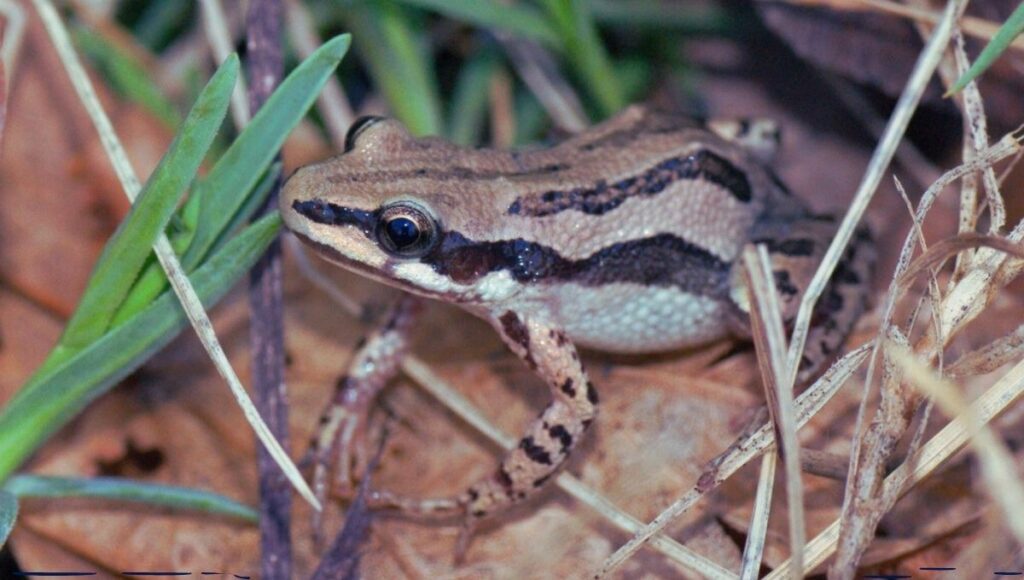
Western chorus frogs can be very enticing, unique, and different choices as pets. Unavailability at the pet market and thriving in difficult environments could be a big reason why most people don’t show interest in having midland chorus frogs as pets. Replicating their natural environment at home is very difficult because the frogs thrive in a low temperature (around 0°C or 32°F). Any temperature beyond 10°C or 50°F will be dangerous for the frogs.
Also, the midland chorus frogs don’t like to be handled by humans and hence you cannot touch them unnecessarily. Thus, if you can maintain such low temperatures and prevent yourself from touching them, these chorus frogs can be a nice and unique choice as pets.
How can you buy Midland chorus frogs?
Midland chorus frogs are very difficult to find in pet markets. However, you may find them at illegal pet markets but they are mainly illegally captured from the wild and unhealthy. Hence, it is advised to buy these chorus frogs only from either reputed breeders or pet shops that can ensure the frog is born and bred in captivity and healthy. You can also check online platforms to find the frogs. Don’t forget to ask for proof of origin and health certificate before buying. If you are purchasing Western Chorus Frogs online, check their reviews, policies, and other important information.
Requirement and Care:
Enclosure and Substrate:
The small-sized frogs require a 10-gallon reptile tank with a secure lid and proper ventilation systems. Ventilation systems help in maintaining the humidity level which is very important for the survival of chorus frogs. Additionally, some live or artificial plants along with rocks, logs, and barks must be required as these terrestrial objects help the frogs to hide and hibernate.
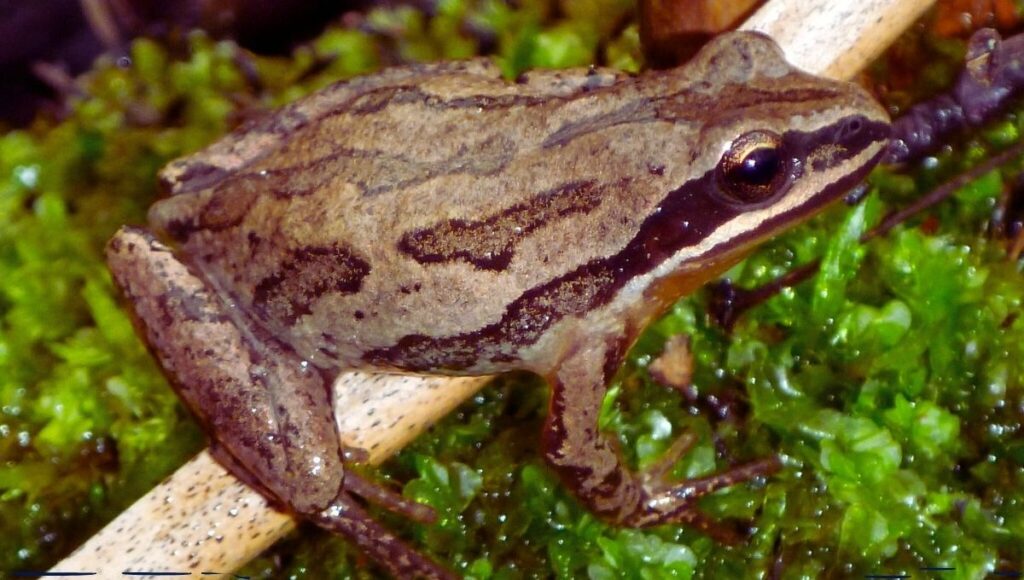
Western chorus frogs are semi-aquatic amphibians and live mainly in temporary waterbodies most of the time. Hence, at least 50% of the tank should be covered by dechlorinated and pollution-free water. 50% of the water must be changed daily and filled with clean and fresh water. Dead insects, waste food, and water dishes of the frogs should be cleaned daily to prevent any bacterial or fungal growth.
Any substrates that can hold moisture can be suitable for the chorus frogs. However, leaf litter, logs, and cork barks must be present on the ground with the substrate. You can use sphagnum moss, peat moss, coco fibre or a mixture of coco fibre with moist soil can be used as substrates.
Can you keep two or more Western Chorus frogs in the same tank?
Cannibalistic nature has been seen in the frog species and hence it is advised not to keep two or more Western chorus frogs in the same tank or they might kill each other. If you want to keep them in the same tank, ensure the frogs have enough space between them and that every frog in the enclosure is similar in size.
Temperature and Humidity:
Midland chorus frogs live at high altitudes and hence they prefer a cold and moist environment to live in. Any temperature from 0-4°C or 32-40°F will be perfect for the frogs to thrive. If the temperature is beyond 10°C or 50°F then it might cause harm to the chorus frogs. Hence, it is very important to keep the enclosure in the coldest corner of your house. Because it is very easy to warm the tank up if it is cold but it is very difficult to cool down the tank if it is warm.
Additionally, you need to maintain at least 80% humidity level to match the frog’s native environment. You can use a digital thermometer and hygrometer to monitor the temperature and humidity level. You can use a fogger or mist maker to maintain the humidity without doing much effort. You can also sprinkle water several times a day in the enclosure to maintain the humidity level high.
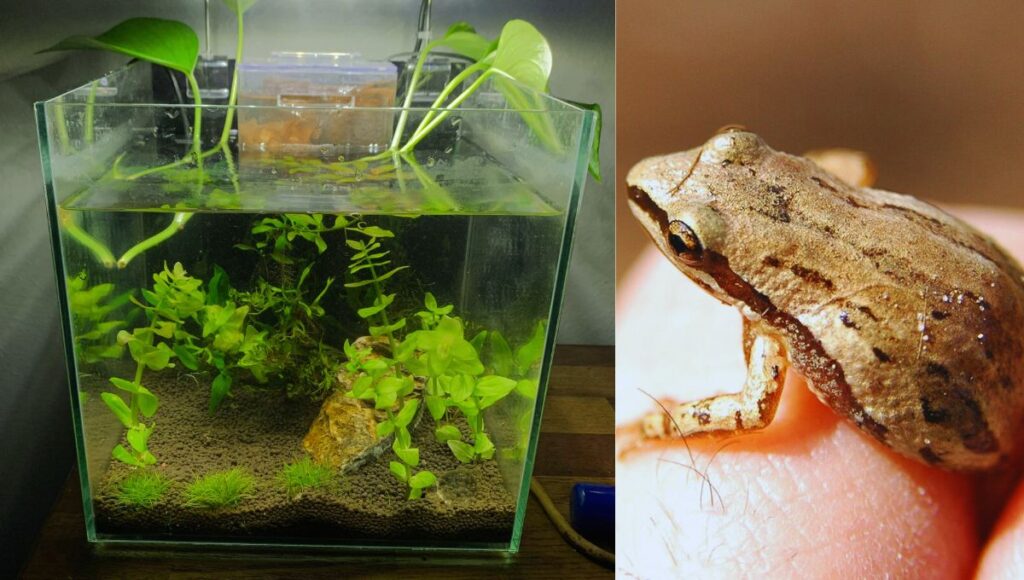
Lights:
Like any other frogs, Western chorus frogs require a 12-hour day and night circle to regulate their daily activities. A very low-wattage UVA/UVB bulb that doesn’t warm up the enclosure can solve this problem as well as provide vitamin D that the frogs don’t get from sunlight.
Food and Supplements:
Living in a very cold environment, midland chorus frogs have a very slow digestive system and they need very little food compared to other frogs. Providing an adult with three to four gut-loaded crickets, wax worms, or mealworms once every three days is sufficient to prevent the frogs from obesity. However, the tadpoles need to be fed daily with algae as they are herbivorous.
Being an owner, ensure there is enough fresh and dechlorinated water in the enclosure because the frogs are mostly semi-aquatic amphibians. If any kind of pollution, chemicals, and pesticide enters the enclosure, either through food or water, can be very dangerous for the Western chorus frogs. Once in two weeks dust their food with calcium and vitamin supplements to provide them with proper nutrients.
Handling:
Midland chorus frogs don’t like to be handled by humans. The frogs often try to avoid human presence in their habitat. They often stop calling and dive into water or leaf litter to hide if they find any kind of human presence. You can watch them through the transparent wall of the tank and enjoy their activities. But don’t touch them unnecessarily or it’ll cause stress to the frogs.
With proper care and maintenance, Western Chorus frogs can live up to 8 years in captivity. Hence, respect the personal spaces and likes of your frogs to keep them healthy.
Reference: Western chorus frogs Wikipedia
Also Read: Are Carpenter Frogs Suitable Pets For Beginners? A Perfect Pet Guide
Also Read: Are Wallace’s Flying Frogs (Gliding Frogs) Good Pets? A Complete Pet Guide